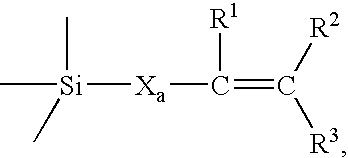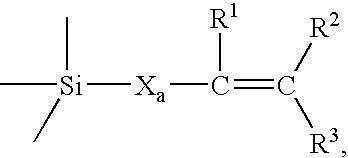Silicone binders for investment casting
a technology of silicone binders and investment casting, which is applied in the field of investment casting, can solve the problems of reducing the strength of the cast parts, poor mechanical properties of the investment casting core made using low pressure casting techniques, and difficulty in ejecting cast parts from the metal die, so as to improve the slurries of ceramics, improve the dimensional accuracy and mechanical properties, and be more robust
- Summary
- Abstract
- Description
- Claims
- Application Information
AI Technical Summary
Benefits of technology
Problems solved by technology
Method used
Image
Examples
example 1
[0057]In this example, a 38% by volume ceramic article was cast using a mixture of 1,3,5,7-tetravinyl-1,3,5,7-tetramethylcyclotetrasiloxane and a poly[(methylhydrogen)-co-(dimethyl)]siloxane. In this case, the vinyl to silicone hydride molar ratio was maintained at 1:1. The ceramic was a mixture of amorphous silica and zircon. A 422 gram batch was prepared by mixing the various constituents for 15 seconds in a high-shear mixer operating at 2,500 rpm. Following mixing, the batch was degassed using a rotary vacuum mixer for 5 minutes operating at roughly 50 torr and 60 rpm.
[0058]The batch was then cast into a mock investment casting core by infiltrating a specially-designed steel die with the slurry at roughly 10 psi pressure. Following casting, the part was cured at 100° C. for roughly 30 minutes prior to part ejection. Following ejection, the part was cooled to room temperature.
[0059]Following casting, the part was fired in air at a rate of 10° C. per hour to a temperature of about ...
example 2
[0060]Ceramic test bars were cast using a mixture of 1,3,5,7-tetravinyl-1,3,5,7-tetramethylcyclotetrasiloxane and 1,3,5,7-tetramethylcyclotetrasiloxane in a molar ratio of 1:1. The ceramic was a mixture of amorphous silica and zircon, present at 40% by volume. A 177.8 gram batch was prepared by mixing the constituents for 10 seconds in a high-shear mixer at 2,500 rpm. Following mixing, the batch was degassed in a rotary vacuum mixer for 5 minutes at roughly 50 torr and 60 rpm.
[0061]The batch was then loaded into disposable transfer syringes, and hand injected into a custom designed steel casting die. Approximate die opening dimensions were 0.1″×0.5″×5″. Following casting, the articles were cured at 50° C. for roughly 90 minutes prior to removal. The resultant article had a smooth hard surface, was strong and resilient, and could be readily handled without breaking.
example 3
[0062]Ceramic test bars were cast using a mixture of 1,3,5,7-tetravinyl-1,3,5,7-tetramethylcyclotetrasiloxane and a hydride functional silicate resin corresponding to Formula (VII), containing hydridodimethylsiloxy and silicate units in a molar ratio of 2:1. The total silicon hydride to vinyl molar ratio was 1:1. The ceramic was a mixture of amorphous silica and zircon, present at 40% by volume. A 177.8 gram batch was prepared by mixing the constituents for 10 seconds in a high-shear mixer at 2,500 rpm. Following mixing, the batch was degassed in a rotary vacuum mixer for 5 minutes at roughly 50 torr and 60 rpm.
[0063]The batch was then loaded into disposable transfer syringes, and hand injected into a custom designed steel casting die. Approximate die opening dimensions were 0.1″×0.5″×5″. Following casting, the articles were cured at 50° C. for roughly 90 minutes prior to removal. The resultant article had a smooth hard surface, was strong and resilient, and could be readily handled...
PUM
| Property | Measurement | Unit |
|---|---|---|
| temperatures | aaaaa | aaaaa |
| temperature | aaaaa | aaaaa |
| pressure | aaaaa | aaaaa |
Abstract
Description
Claims
Application Information
 Login to View More
Login to View More - R&D
- Intellectual Property
- Life Sciences
- Materials
- Tech Scout
- Unparalleled Data Quality
- Higher Quality Content
- 60% Fewer Hallucinations
Browse by: Latest US Patents, China's latest patents, Technical Efficacy Thesaurus, Application Domain, Technology Topic, Popular Technical Reports.
© 2025 PatSnap. All rights reserved.Legal|Privacy policy|Modern Slavery Act Transparency Statement|Sitemap|About US| Contact US: help@patsnap.com



